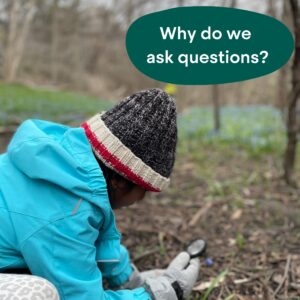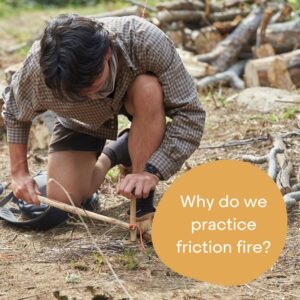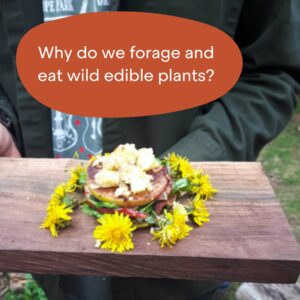Wondering why we engage in certain nature connection practices and activities at Pine? You’ve come to the right place! In our “Why We” series, we’re sharing the inside scoop on the benefits of different activities and why we choose to integrate them into our nature connection programs.

Why do we ask so many questions at Pine programs (and often don’t immediately give answers!)?
The “Art of Questioning” forms the foundation for much of what we do at Pine. One of the most important things we can do with kids is to empower their sense of curiosity and help them learn how to learn. Doing so fosters resilient self-starters!
? It builds connections between mentors and children. Learning together engages everyone in the group and makes the journey a collaborative process, rather than creating power imbalances between adults with an answer and children without.
? Providing one answer doesn’t work for everyone and is easy to forget. By inviting kids to be part of the learning process, it allows them to come to an answer that makes sense to them and forms memories that aid in knowledge retention.
?? It promotes resilience within the group. When a group works together to ask a question and problem solve, collecting 7 different solutions creates a more resilient situation than only having 1!
? It fosters independence. If an adult always has the answer, it can create dependence. By starting to share leadership and responsibility for having to pay attention and figure things out for themselves, kids can go out into the world and continue learning for themselves.
✨ Asking good questions is inspiring to kids and can open a whole new world of learning, wonder and relationship with nature. It encourages them into be in the moment, open their senses, and form relationships with living things around them.
? It teaches patience. Sometimes it takes a long time to come to an answer and that’s ok!
Of course, it’s called an “art” for a reason! It’s a fine balance between using questions to create inspiring and welcoming experiences vs. frustrating and discouraging ones. Mentors must be skilled in identifying opportunities in the environment, recognizing when kids are engaged by them, asking good questions and offering enough information to spark curiosity. Pine mentors train and practice to be experts in the Art of Questioning!

Why do we practice creating fires by friction at Pine programs? ?
? It’s a source of profound inspiration for many! There are few things that spark excitement as much as someone rubbing two pieces of wood together and ‘getting their first coal’. That excitement can act as a gateway to deep learning journeys.
? It builds relationships to the trees and natural materials that we source and work with to make our friction fire kits and create fire. To practice friction fire, we must learn about the natural materials we’re using – What type of wood is best for a spindle vs. fireboard? Which trees provide good tinder? How does the wood feel when carving? Engaging physically and intellectually strengthens our understanding of and appreciation for nature.
? It connects us to our own heritage and invites us to learn about other cultures. Humans all around the world have tended fires for thousands of years. We can ask ourselves, why did different cultures use different techniques and why? What importance did fire hold for them historically? How do those relationships continue to show up today?
? Doing something the hard way creates challenge that fosters growth. When we practice friction fire, we are forced to put in hard work, engage in trial and error, experience failure, and learn from our mistakes. By overcoming difficulty, we feel incredible pride in our achievements and develop confidence in our abilities.
? It inspires gratitude for what we have and what nature provides. We often hear kids reflect on how much harder it is to start a fire to cook their meal than it is to turn on a stovetop. How grateful we are for modern conveniences! They also recognize what the cedar or oak had to give in order to make their bow drill, and share gratitude for its sacrifice.
Why do we forage and eat wild edible plants? ?
? It fosters a deep respect for the land and strong stewardship values by building an understanding of who the plants are, how we rely on them, and our responsibility to care for them. As Robin Wall Kimmerer writes in describing the Honourable Harvest in ‘Braiding Sweetgrass’, “Know the ways of the ones who take care of you, so that you may take care of them.” As humans, we need plants in order to survive and care for ourselves, but how can we do this with respect and reciprocity? In learning about this and other teachings of the Honourable Harvest, we can learn to be better Treaty people and stewards of the land. Pine operates in many spaces, inside and outside of the city. Part of stewardship means allowing the health of an ecosystem to guide us. In dense urban and high traffic areas where plants are limited or stressed, we often avoid harvesting (and stay on trails to allow the plants to grow where they can!). Instead, we focus on taking only in abundant areas and where we can minimize harm.
? It encourages us to think about where our food, clothes, and other materials come from. In today’s world, it can be easy to forget that we rely on other living things to survive, even the air that we breathe! Recognizing these gifts deepens our appreciation, changes the choices we make, and empowers us to better our impact on the world.
⚠️ It teaches us risk management. We learn about the ways that plants can help and hurt us. Understanding these risks teaches us how to safety navigate our environment, think critically, and make good decisions.
? It opens up cool science discussions, like how plants grow, the roles they play in their ecosystem, what nutrients they offer, or why adding lemon changes violet syrup from blue to purple to pink?!
? It’s a huge source of inspiration and sparks new excitement around nature! There are few things we’ve seen that get kids more excited than asking, “Can I eat it!?”
With the burst of new growth happening, spring is a great time to explore plants in your area. Head outside and meet some new plant friends! (But remember to engage with respect and only interact with those you know)
 Why do we intentionally engage our SENSES, like listening to bird language and smelling flowers?
Why do we intentionally engage our SENSES, like listening to bird language and smelling flowers?
? It’s a great way to meet other living things that share our home. Engaging with and getting to know our shared environment creates a deep sense of comfort and belonging.
☀️ It creates real, in-the-moment experiences, getting us off our screens, out of our heads, and away from our stresses.
? It slows us down. Instead of walking through natural spaces, we get to know and create stories about our home place, deepening our connection.
? “Stop and smell the roses” might be a cliché, but research shows it’s good advice! Studies have found that taking time to smell flowers boosts our happiness and life-satisfaction. Some floral scents can even fight inflammation and depression, and increase information retention and learning success!
?? Paying attention with our ears is a great opportunity to practice being curious. Curiosity is the key to an active mind that loves learning, finds excitement in each moment, and is open to new ideas.
? Birds and bird language give us feedback on how we’re moving through the world and provides a lens to think about how we’re interacting with others. We can ask – Am I moving or acting in a way that scares others or allows them to continue in their normal behaviours? Am I just worrying about myself or listening to others and how they react?
? It’s good design to pay attention to the things that allow us to survive on this planet. When we foster more connection to the plants, animals, and natural systems that clean our air and water, feed us, house us and clothe us, rather than to our screens, we inspire a love for nature and a desire to keep it safe.
Building relationships with nature through these direct, curiosity-filled experiences is great for our own mental health, as well as the health of the Earth. Spring is the perfect time to get out and engage your own senses – try it out!

Why do we engage in CRAFTING, like cordage-making, basketry and weaving, sewing and leather work?
![]() Using our hands adds an element of learning that is often missing in today’s head-focused conventional education systems. Hands-on work stimulates different areas of our brains and engages our attention in new ways. At Pine, we often work with kids who have trouble paying attention during some activities, but when taught to create cordage are able to listen and concentrate.
Using our hands adds an element of learning that is often missing in today’s head-focused conventional education systems. Hands-on work stimulates different areas of our brains and engages our attention in new ways. At Pine, we often work with kids who have trouble paying attention during some activities, but when taught to create cordage are able to listen and concentrate.
![]() Studies have shown that working with our hands is good for our mental health – increasing our mood, relieving stress, reducing anxiety, and combating depression.
Studies have shown that working with our hands is good for our mental health – increasing our mood, relieving stress, reducing anxiety, and combating depression.
![]() Working with natural materials builds a tangible relationship with the land in a way that fosters respect. When we are able to directly interact with the plants and animals around us, we can more clearly understand how nature supports us and the impact we can have in return. By recognizing the source of materials and acknowledging the sacrifice that is needed, we can learn to be good stewards of the land.
Working with natural materials builds a tangible relationship with the land in a way that fosters respect. When we are able to directly interact with the plants and animals around us, we can more clearly understand how nature supports us and the impact we can have in return. By recognizing the source of materials and acknowledging the sacrifice that is needed, we can learn to be good stewards of the land.
![]() Skills like crafting form the physical aspect of relationship-building, helping us to fall in love with living things and get to know them in a way that a solely intellectual connection doesn’t allow.
Skills like crafting form the physical aspect of relationship-building, helping us to fall in love with living things and get to know them in a way that a solely intellectual connection doesn’t allow.
![]() There’s a lot of small, acceptable failure involved in crafting, and that’s a good thing! When we watch others do something, try it ourselves, fail to get the result we want, adapt our approach and finally succeed, it teaches us to problem-solve and make our relationship with failure a positive one.
There’s a lot of small, acceptable failure involved in crafting, and that’s a good thing! When we watch others do something, try it ourselves, fail to get the result we want, adapt our approach and finally succeed, it teaches us to problem-solve and make our relationship with failure a positive one.
![]() Crafting is a form of art. Crafting beautiful things invites us to be creative, express ourselves, communicate our feelings in new ways, and take pride in a final product.
Crafting is a form of art. Crafting beautiful things invites us to be creative, express ourselves, communicate our feelings in new ways, and take pride in a final product.
With the warming weather, we’re shedding our gloves for more and more crafting time at Pine programs. Join us! It’s the perfect time to craft dandelion crowns check out these instructions for more.